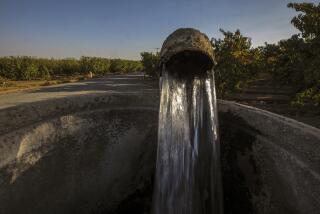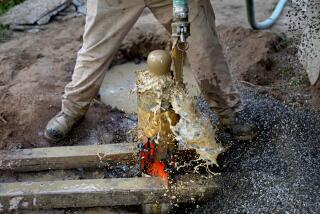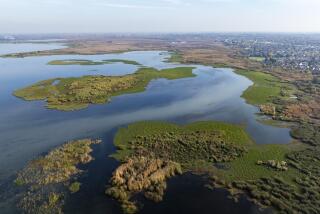Op-Ed: The ludicrous plan to pump Mojave water to L.A.

In 1992, prospectors in Los Angeles hatched an idea for a new water supply that was improbable and speculative, even by Southern California standards. Far off in the Mojave Desert, beneath the flat dry lake bed of the Cadiz Valley, millennia’s worth of groundwater could be pumped and piped 43 miles to the Colorado River Aqueduct, the crown jewel of the Metropolitan Water District’s massive web of infrastructure. The water then could be sold to any of the 26 member agencies of the MWD. This scheme came to be called the Cadiz Valley Water Conservation, Recovery and Storage Project, now known as the Cadiz project. It is owned by a publicly listed corporation, Cadiz Inc., which in 25 years has yet to turn a profit.
After decades of court battles, mixed environmental reviews and bleak investor reports, the Cadiz project has recently taken a few steps forward. In a decision issued last May, an appellate court certified that Cadiz Inc. has the legal right to 50,000 acre-feet of the Mojave groundwater per year for the next 50 years. Then, early last month, the White House removed a restriction on a federal railroad right of way, effectively allowing Cadiz to build a new pipeline for moving the water to the existing aqueduct without undergoing a federal environmental review. And now a Cadiz lobbyist and shareholder, David Bernhardt, is under consideration for the No. 2 position at the Department of Interior, where, if confirmed by the Senate, he would help decide the future of the project.
For the record:
12:12 a.m. Sept. 24, 2024This story originally stated that Cadiz set a cost goal for its water of $150 per acre foot. Actually, that was the estimate for treating the water. The story also stated that the project was named the Cadiz Valley Water Conservation, Recovery and Storage Project in 1992. The project was given this name in 2009.
In many ways, the Cadiz project is consistent with Southern California’s miraculous and controversial water history. A $1-trillion economy now exists in what was once a scarcely inhabited flood basin thanks to prodigious feats of civil engineering. There is enough water to support our way of life because the Los Angeles Aqueduct, the State Water Project, the Colorado River Aqueduct and the All American Canal bring it here.
The closer a water source is to where the water gets used, the better.
But Cadiz’s vision is now out of step with the times. In the decades since the project was conceived, water planning has moved away from the centralized, over-engineered projects of the past to decentralized infrastructure that is more resilient and efficient. Just as telecommunication grids are migrating from wired lines to mobile networks, and electricity generation from power plants to community-level solar power, our water infrastructure, too, is becoming more localized. The closer a water source is to where the water gets used, the better.
Examples of this new-style water infrastructure are underway all over Southern California. There are more than 30 new water recycling projects in operation or in development, converting reclaimed wastewater into potable water, according to the WateReuse Assn., in addition to dozens of non-potable water recycling projects. At least four new desalination plants are in operation or development in Southern California, designed to supply water to their immediate communities. And plans to crack the concrete of the Los Angeles River and other flood channels will capture millions of gallons of stormwater a year.
Simple economics drove this change. The cost of moving water long distances has grown, while lower costs of technology and other factors have made these smaller, decentralized projects less costly. Also, in California and elsewhere, many large-scale water schemes have been revealed as vulnerable (the State Water Project crosses the San Andreas Fault 32 times) and increasingly expensive to maintain (see: Dam, Oroville).
After four years of drought — the worst on record — the biggest surprise for most water planners was not Southern California’s scarcity, but the region’s adaptability. California’s overall water use has been in decline since peaking in 1995 even as the state’s population has grown, thanks to low-flow fixtures, turf removal and other conservation measures. We now know that any new need for additional water could be more than offset by a combination of these conservation measures, water reuse projects, seawater desalination facilities, stormwater capture and groundwater recharge efforts.
Cadiz has set an estimate cost for their water of $775 and $960 per acre-foot, and other estimates put the cost at $850 per acre-foot. MWD’s current average price of untreated water is $670 per acre-foot. This means that water users who buy Cadiz water would see a rate increase for a project that no longer is necessary. What’s more, taxpayers paid for the construction of the Colorado River Aqueduct, and MWD water users pay the cost of its operations and maintenance. We would be footing the bill for Cadiz in more ways than one.
If water users were presented with a choice between the cost of Cadiz and conservation, they almost certainly would prefer to conserve. It’s only the absence of true price transparency and customer choice that has allowed a project as fraught and flawed as Cadiz to move forward. We already are looking at $1 trillion in deferred spending on maintenance and enhancement of our existing water infrastructure around the country. This infrastructure should get the attention it needs before we break ground on anything as speculative as the Cadiz project. (Again, see: Dam, Oroville.)
There is another factor that undoubtedly will raise the cost of the Cadiz project, a factor so worrisome the company buried it deep inside its SEC investment risk disclosures. Cadiz groundwater contains the carcinogen hexavalent chromium, or chromium 6. Although chromium 6 can be treated, Cadiz’s plan is unconvincing at best: The company claims that by blending Mojave water with Colorado River water, the chemical will be diluted to safe levels. The legal limit is in dispute, with the California Department of Public Health recommending a limit of 10 parts per billion (ppb), and courts allowing up to 50 ppb. Still, MWD’s water currently has no detectable chromium 6, while Cadiz’s water contains the carcinogen at levels up to 16 ppb.
Cadiz would be detrimental to more than just Californians’ wallets. Opponents of the project correctly argue that the extraction of 50,000 acre-feet per year is unsustainable, putting the area’s sensitive freshwater springs and delicate desert ecosystems at risk. (According to Cadiz’s own analysis, the average annual replenishment volume of water is only 32,000 acre-feet.) Moreover, if history is any indication, it is unlikely that Cadiz would keep to the 50,000 acre-feet over 50 years. One need only look to the Owens Valley for an example of what happens when a thirsty metropolis dips a straw into a far-flung water resource. The temptation for overuse would be too great to resist.
Cadiz claims the project has been delayed because of environmental obstructionism and burdensome regulations. In fact, the project has struggled because it fails on its merits. While technically feasible and legal, it presents significant economic, engineering, quality, sustainability and environmental challenges, and is made even less desirable by a recent surge in cheaper, less risky alternatives. Southern California would be wise to move beyond the outdated methods of the Cadiz project and welcome a new generation of ideas for securing water.
Peter H. Brooks is the vice president of a water technology firm in Southern California who lives part time in the Mojave Desert. He previously was a U.S. Marine infantry officer stationed at Twentynine Palms and executive director of the Harvard Water Federalism Project.
Follow the Opinion section on Twitter @latimesopinion or Facebook
MORE FROM OPINION
Dear LAPD: You are not exempt from the Public Records Act
The forces that shut down Ringling Bros. want to end a lot more than animal abuse
Gil Cedillo’s close call is an object lesson for City Hall: Angelenos are tired of business as usual
California’s Prop. 47 revolution: Voters were sold a bill of goods
More to Read
A cure for the common opinion
Get thought-provoking perspectives with our weekly newsletter.
You may occasionally receive promotional content from the Los Angeles Times.










